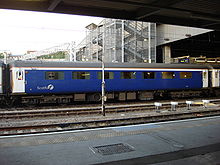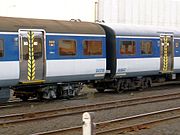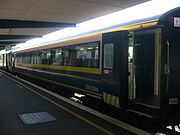- NZR British Rail Mark 2 carriage
-
NZR British Rail Mark 2 
The eight S class carriages used on the Capital Connection, pulled by WAB 794 on an excursion near Woodville on 31 August 2003.
The interior of an SE carriage, used on Metlink peak services in Wellington.In service 1971-present (UK)
1998-present (NZ)Manufacturer BREL Built at Derby Carriage and Wagon Works, Derby, England Constructed 1971-1975 Entered service 1998-present Refurbishment Hillside Engineering, Dunedin
Hutt Workshops, Lower HuttNumber built 1,876 (UK) Number in service 112 (NZ) Fleet numbers previous BR numbers Capacity 31 - 64 Operator Tranz Scenic
Tranz Metro
VeoliaLine(s) served North Island Main Trunk (Wellington-Palmerston North, Pukekohe-Britomart)
North Auckland Line (south of Helensville)
Auckland - Newmarket Line
Wairarapa Line (Wellington-Masterton)Specifications Car length 19.66 metres (64 ft 6 in) Width 2.82 metres (9 ft 3 in) Height 3.89 metres (12 ft 9 in) Floor height 1.07 metres (3 ft 6 in) Maximum speed 160 km/h (100 mph) design Weight 34 tonnes (33 long tons; 37 short tons) Power supply Diesel generator in SD/SEG/SWG Train heating Electric Gauge 1,067 mm (3 ft 6 in)
(originally 1,435 mm (4 ft 8 1⁄2 in))British Rail Mark 2 carriages used in New Zealand were imported from the United Kingdom and rebuilt/refurbished and re-gauged in New Zealand.
The carriages are used on the Capital Connection (S class), owned operated by Tranz Scenic; MAXX commuter trains in Auckland (SA/SD classes), owned by Auckland Transport and operated by Veolia; and on the Metlink Wairarapa Connection (SW/SWG/SWS class) and peak services in Wellington (SE/SEG/SES class), owned by Greater Wellington Regional Council and operated by Tranz Metro. They generally replaced NZR 56-foot carriages, some of which had been in use for almost 70 years.
Contents
History
In Britain
Further information: British Railways Mark 2The British Rail Mark 2 was the second design of carriage by British Railways (BR). The first Mark 2 was a prototype First Corridor (FK), 13252, built in 1963.
1,876 Mark 2 carriages were constructed at the Derby Carriage and Wagon Works between 1964 and 1975. In 1975 the Mark 2 was superseded by the Mark 3, which had been developed for the InterCity 125 high speed train. The last Mark 2 was built in 1977, departmental carriage 999550.
The Mark 2 was one of the mainstays of BR's InterCity network until the privatisation from 1994. Since privatisation, new rolling stock has replaced the Mark 2 on nearly all routes. They are still used in revenue service by Arriva Trains Wales and First ScotRail, and also on many private rail tours, charter trains and heritage railways.
In New Zealand
New Zealand has about 3,900 kilometres (2,400 mi) of 1,067 mm (3 ft 6 in) Cape gauge railway, chosen due to the mountainous terrain. Because of construction constraints, most New Zealand rail lines have a limited loading gauge. Great Britain uses 1,435 mm (4 ft 8 1⁄2 in) Standard gauge, but its loading gauge is only slightly larger than New Zealand's. This means that BR rolling stock, like the Mark 2 carriage, can run on most New Zealand lines after gauge conversion.
National rail operator Tranz Rail and heritage operator Mainline Steam bought 69 Mark 2 carriages (one damaged by fire after arrival) in 1996. Eight were extensively refurbished for the Wellington–Palmerston North Capital Connection, classified S (for Scenic), with new Japanese-assembled bogies. The carriages featured new auto plug doors and interiors. The initial refurbishment proved more costly than expected, and the remaining carriages were laid up until a rebuilding programme began for the Auckland Regional Transport Authority for use on Auckland suburban trains. Classified SA/SD, they have two sets of sliding doors each side and are operated by Veolia for MAXX in push-pull mode, with DC (4-car) or DFT (6-car) locomotives leased from KiwiRail. The SD carriages include a driver's cab and operate in a similar manner to DBSOs in the UK.
In the southern autumn of 2006, Mark 2E and 2F carriages formerly operated by 'one' Anglia that had been replaced by ex-Virgin Mark 3 stock were exported to New Zealand. These were bought by Greater Wellington Regional Council for operation by Tranz Metro on the Wairarapa Connection between Wellington and Masterton. They were rebuilt at Hillside Workshops in Dunedin, and classified SW, SWG and SWS.
Six more carriages have been bought by Greater Wellington Regional Council for operation on Metlink trains between Wellington, Upper Hutt and Plimmerton, top-and-tailed by EO electric locomotives. These have been refurbished by Hillside Workshops and classified SE, SEG and SES.
Mainline Steam brought 15 Mark 2 carriages to NZ in 1996, and subsequently sold them to Tranz Rail. Between 2006 and 2008 they purchased 13 more Mark 2 carriages, which were shipped to NZ in 2008. These carriages are being rebuilt at Mainline Steam's Plimmerton depot, and will use the X27750 "Kinki" bogie and generally retain their internal fittings and appearance, with some differences such as toilet retention tanks and retractable steps. Currently four of these cars are at Plimmerton, with the other nine stored at Hutt Workshops. The first of these carriages are not expected on the main line until later in 2011, when sufficient numbers of the cars have been overhauled to make a set.
In late 2009, all S, SE and SW carriages were required to be modified so that their pneumatically-operated interior doors open automatically if the compressed air supply is lost. This was identified as an issue after the locomotive on a Wairarapa Connection train derailed when it hit a landslide on 23 July 2009, resulting in the locomotive having to be shut down, cutting the compressed air supply to the SW carriages. The doors stuck in position, and three people were required to open them manually, sparking safety fears that the carriages cold not be evacuated quickly in the event of a fire.[1]
All New Zealand Mark 2 carriages in regular service retain their BR numbers, though the Mainline Steam cars may receive new numbers.[citation needed]
Classes
There are five classes of Mark 2 carriages operating in New Zealand, with two classes having two sub-classes each. All are rebuilt from Mark 2D, 2E, or 2F First Open (FO) or Tourist Standard Open (TSO) carriages.
S class
The eight S (Scenic) carriages operate on Tranz Scenic's Capital Connection between Wellington and Palmerston North, each seating 60 (except the servery car, which seats 31) in both alcove and airline-style arrangements. They are painted in the Capital Connection livery of light and dark blue.
SA class
SA (Suburban Auckland) carriages operate on the MAXX suburban network, owned by Auckland Transport and operated by Veolia Auckland. They operate in sets of three to five cars, an SD (see below) and a DC (4- and 5-car) or DFT/DFB (6-car) diesel-electric locomotive in push-pull configuration. They have electronic double doors, and are painted in the MAXX livery of blue and grey. There are two types of bogies: re-used bogies from 56 foot carriages, and new bogies with air-cushion secondary suspension.
SD class
SD (Suburban Driving) carriages also operate on the Auckland suburban network. The 24 carriages are fitted with a driving cab to allow trains to operate in push-pull mode, similar to British Rail Mark 2 Driving Brake Standard Open (DBSO) carriages. They have diesel generators to power the SA and SD carriages in the train. They are painted in MAXX livery.
SW class
The SW (Suburban Wairarapa) type is owned by Greater Wellington Rail Ltd, a subsidiary of the Greater Wellington Regional Council, leased to KiwiRail's Tranz Metro to operate on Metlink's Wairarapa Connection between Wellington and Masterton. There are 18 SW type carriages - 12 SW, three SWS and three SWG. The cars are in three sets of three to seven cars depending on the service (peak, off-peak, weekend), and all consist of an SWG, an SW, an SWS, and then the remaining SW cars. Some trains have a luggage/generator van, AG222, to supplement or replace the SWG.
SW carriages have 64 seats in both alcove and airline-style arrangements. They have toilets at each end of the carriage, automatic doors, and a public information system. SWS carriages have 37 seats, with a servery, a wheelchair hoist and a disabled toilet. SWG carriages also have 37 seats, and have a luggage compartment, and a diesel generator to power the carriages.
The carriages are painted in Metlink livery of dark blue and grey, with lime green highlights.
SE class
The SE (Suburban Express) type is similar to the SW, owned by Greater Wellington Rail Ltd and operated by Tranz Metro on peak express services top-and-tailed by EO class electric locomotives. There are four SE, one SES and one SEG carriages.
SE cars received a less thorough rebuild than the SWs, and retain their original airline-style seating. The SES carriage is accessible like SWS carriages, but lacks the servery.
They are painted in the Metlink livery. They are a temporary measure to increase capacity until arrival of the FP class "Matangi" units in 2010/2012, after which they may be transferred to increase capacity on the Wairarapa Connection.[2]
Two SA cars, showing re-used (left) and new (right) bogiesThree SA cars and an SD car with DC4409 on a test run at MastertonSW3394 at Masterton on a Wairarapa Connection serviceClass register
Key: In service Out of service Auckland Transport service Preserved Overhaul Scrapped Class BR type Number Service/area Entered Service S 2D FO 3170 Capital Connection 15 November 1999 SA 2D FO 3171 Auckland suburban S 2D FO 3177 Capital Connection 15 November 1999 S 2D FO 3184 Capital Connection 15 November 1999 SA 2D FO 3185 Auckland suburban S 2D FO 3190 Capital Connection 15 November 1999 SA 2D FO 3193 Auckland suburban SA 2D FO 3195 Auckland suburban SD 2D FO 3197 Auckland suburban SD 2D FO 3199 Auckland suburban S 2D FO 3200 Capital Connection 15 November 1999 SA 2D FO 3201 Auckland suburban SA 2D FO 3205 Auckland suburban SA 2D FO 3206 Auckland suburban S 2D FO 3207 Capital Connection 15 November 1999 S 2D FO 3211 Capital Connection 15 November 1999 SA 2D FO 3212 Auckland suburban SA 2D FO 3216 Auckland suburban SA 2E FO 3224 Auckland suburban SA 2E FO 3233 Auckland suburban S 2E FO 3245 Capital Connection 15 November 1999 SA 2E FO 3262 Auckland suburban SA 2E FO 3263 Auckland suburban SA 2E FO 3265 Auckland suburban SA 2E FO 3266 Auckland suburban SW 2F FO 3282 Wairarapa Connection November 2007 SE 2F FO 3288 Wellington suburban December 2008 SW 2F FO 3294 Wairarapa Connection 4 September 2007 SWS 2F FO 3298 Wairarapa Connection 11 October 2007 SE 2F FO 3311 Wellington suburban December 2008 SE 2F FO 3324 Wellington suburban December 2008 SES 2F FO 3327 Wellington suburban December 2008 SW 2F FO 3339 Wairarapa Connection 19 June 2007 SW 2F FO 3349 Wairarapa Connection 11 October 2007 SW 2F FO 3355 Wairarapa Connection 11 October 2007 SWG 2F FO 3365 Wairarapa Connection 14 May 2007 SW 2F FO 3376 Wairarapa Connection 19 June 2007 SE 2F FO 3380 Wellington suburban December 2008 SW 2F FO 3394 Wairarapa Connection 19 June 2007 SW 2F FO 3404 Wairarapa Connection November 2007 SWG 2F FO 3422 Wairarapa Connection 11 October 2007 SEG 2F FO 3430 Wellington suburban December 2008 SA 2D TSO 5617 Auckland suburban SD 2D TSO 5624 Auckland suburban SD 2D TSO 5626 Auckland suburban SA 2D TSO 5633 Auckland suburban SA 2D TSO 5637 Auckland suburban SA 2D TSO 5638 Auckland suburban SW 2D TSO 5646 Wairarapa Connection 4 September 2007 SA 2D TSO 5651 Auckland suburban SD 2D TSO 5652 Auckland suburban SA 2D TSO 5653 Auckland suburban SA 2D TSO 5654 Auckland suburban SW 2D TSO 5658 Wairarapa Connection August 2007 SWS 2D TSO 5660 Wairarapa Connection 14 May 2007 SWG 2D TSO 5671 Wairarapa Connection 24 July 2007 SD 2D TSO 5675 Auckland suburban SA 2D TSO 5682 Auckland suburban SA 2D TSO 5695 Auckland suburban SA 2D TSO 5703 Auckland suburban SA 2D TSO 5705 Auckland suburban SA 2D TSO 5719 Auckland suburban SWS 2D TSO 5723 Wairarapa Connection 24 July 2007 SA 2D TSO 5729 Auckland suburban SA 2D TSO 5730 Auckland suburban SA 2D TSO 5743 Auckland suburban SA 2E TSO 5746 Auckland suburban SD 2E TSO 5747 Auckland suburban SA 2E TSO 5752 Auckland suburban SA 2E TSO 5759 Auckland suburban SD 2E TSO 5761 Auckland suburban SD 2E TSO 5762 Auckland suburban SA 2E TSO 5770 Auckland suburban SA 2E TSO 5776 Auckland suburban SA 2E TSO 5784 Auckland suburban SA 2E TSO 5791 Auckland suburban SD 2E TSO 5794 Auckland suburban SA 2E TSO 5796 Auckland suburban SA 2E TSO 5801 Auckland suburban SD 2E TSO 5811 Auckland suburban SA 2E TSO 5818 Auckland suburban SW 2E TSO 5820 Wairarapa Connection 14 May 2007 SA 2E TSO 5828 Auckland suburban SA 2E TSO 5829 Auckland suburban SA 2E TSO 5835 Auckland suburban SW 2E TSO 5837 Wairarapa Connection 14 May 2007 SD 2E TSO 5843 Auckland suburban SA 2E TSO 5847 Auckland suburban SD 2E TSO 5859 Auckland suburban SD 2E TSO 5860 Auckland suburban SA 2E TSO 5861 Auckland suburban SA 2E TSO 5868 Auckland suburban SA 2E TSO 5873 Auckland suburban SA 2E TSO 5878 Auckland suburban SD 2E TSO 5883 Auckland suburban SA 2E TSO 5887 Auckland suburban SA 2E TSO 5889 Auckland suburban SD 2E TSO 5893 Auckland suburban SA 2E TSO 5902 Auckland suburban SA 2F TSO 5926 Auckland suburban 2009 SA 2F TSO 5935 Auckland suburban 2009 SD 2F TSO 5993 Auckland suburban 2009 SA 2F TSO 5994 Auckland suburban 2009 SA 2F TSO 5996 Auckland suburban 2009 SA 2F TSO 6010 Auckland suburban 2009 SA 2F TSO 6015 Auckland suburban 2009 SD 2F TSO 6026 Auckland suburban 2009 SA 2F TSO 6061 Auckland suburban 2009 SA 2F TSO 6123 Auckland suburban SA 2F TSO 6159 Auckland suburban 2009 SD 2F TSO 6166 Auckland suburban References
- ^ "Report 09-103: Passenger Train 1608, collision with slip and derailment, Tunnel 1, Wairarapa Line, Maymorn, 23 July 2009". Transport Accident Investigation Commission. September 2010. http://www.taic.org.nz/ReportsandSafetyRecs/RailReports/tabid/85/ctl/Detail/mid/483/InvNumber/2009-103/Page/0/language/en-US/Default.aspx. Retrieved 15 August 2011.
- ^ Hayes, Natasha (12 April 2010). "Submissions Report - Draft Wairarapa Corridor Plan" (PDF). Wellington: Greater Wellington Regional Council. p. 6. http://www.gw.govt.nz/assets/council-reports/Report_PDFs/2010_185_1_Report.pdf. Retrieved 24 January 2011
See also
Categories:- Railway coaches of New Zealand
Wikimedia Foundation. 2010.




